Introduction
South Africa is often described as a destination that has it all—majestic landscapes, vibrant cities, fascinating history, and remarkable cultural diversity. Nestled at the southern tip of Africa, the country offers travelers an extraordinary mix of experiences. One day, you might hike to the top of a flat-topped mountain overlooking the ocean, and the next, you could be on safari watching elephants and lions in their natural habitat.
What makes South Africa truly special is the variety it presents within a single nation. Known as the Rainbow Nation, it celebrates its multicultural identity, where traditions from African, European, and Asian communities blend seamlessly. From Cape Town’s world-class dining scene and vineyards to the rugged beauty of the Drakensberg Mountains and the golden beaches of Durban, South Africa promises something unforgettable for every traveler.
This guide provides an in-depth exploration of the country, highlighting its geography, history, culture, and attractions, so you can plan a trip that captures the essence of South Africa.
Geography and Location
South Africa occupies the southernmost region of the African continent. It borders Namibia, Botswana, Zimbabwe, Mozambique, and Eswatini, while surrounding the mountain kingdom of Lesotho. Its unique position gives it access to both the Atlantic Ocean in the west and the Indian Ocean in the east, making it a hotspot for marine life and coastal adventures.
Covering over 1.2 million square kilometers, the country boasts an impressive variety of landscapes. The arid Kalahari Desert lies in the northwest, while the fertile valleys and vineyards of the Western Cape stretch across the south. Inland, the Highveld plateau is home to major cities like Johannesburg and Pretoria. The Drakensberg Mountains in the east feature towering peaks, lush valleys, and ancient rock art sites, making them a haven for hikers and nature enthusiasts.
Climate
South Africa enjoys sunshine for much of the year, but conditions vary depending on the region. The Western Cape, including Cape Town, has Mediterranean-style weather with cool, wet winters and hot, dry summers. The eastern coast around Durban is subtropical and humid, while the interior plateau tends to be dry with summer thunderstorms and crisp winters.
Best Time to Visit
-
For safaris :
-
May to September is best, as the dry season forces animals to gather around rivers and waterholes, making them easier to spot.
-
For beaches and coastal activities:
-
November to March offers warm, sunny weather ideal for swimming and surfing.
-
For hiking and outdoor adventures:
-
Spring (September to November) and autumn (March to May) bring mild temperatures and clear skies.
Thanks to its varied climate zones, South Africa is a year-round destination. No matter the season, you’ll always find regions offering ideal travel conditions.
A Glimpse into South Africa’s History
South Africa’s past is as complex as it is fascinating, shaped by indigenous cultures, colonial encounters, and the long struggle for equality.
Indigenous Peoples
The earliest inhabitants were the San and Khoikhoi, known for their hunter-gatherer and pastoral lifestyles. Later, Bantu-speaking groups such as the Zulu, Xhosa, and Sotho migrated into the region, laying the foundations for much of South Africa’s cultural heritage today.
Colonial Era
European colonization began with the Dutch settlement at the Cape of Good Hope in the mid-1600s, followed by British control in the 19th century. This period saw the rise of Afrikaner culture and conflicts over land and resources. The discovery of diamonds and gold further fueled tensions between colonial powers, settlers, and local communities.
The Apartheid Period
In 1948, the government implemented Apartheid, a rigid system of racial segregation that denied the majority Black population political and economic rights. Townships were created to separate communities, and discrimination was enforced at every level of society. Despite the repression, resistance movements grew stronger, led by figures such as Nelson Mandela, Oliver Tambo, and Steve Biko.
Transition to Democracy
After decades of struggle and international pressure, Apartheid ended in 1994. Nelson Mandela, released from prison after 27 years, became the country’s first Black president. His leadership marked the beginning of a new democratic South Africa, committed to unity and equality.
Today, travelers can experience this history through places like Robben Island, where Mandela was imprisoned, and the Apartheid Museum in Johannesburg. These sites not only preserve history but also serve as powerful reminders of the resilience of the South African people.
Culture and Diversity
South Africa has rightly earned its nickname, the Rainbow Nation, because of its rich cultural variety. It is one of the most diverse countries in the world, where African, European, and Asian influences come together in everyday life. This diversity is visible in the languages spoken, the food enjoyed, and the music and art that shape its identity.
-
Ethnic Groups:
-
South Africa is home to many communities, including Zulu, Xhosa, Sotho, Tswana, Afrikaners, English-speaking South Africans, and a large Indian population in Durban. Each group contributes unique traditions, cuisines, and cultural practices.
-
Languages:
-
With 11 official languages, South Africa embraces its multilingual identity. English is widely spoken, but Afrikaans, Zulu, and Xhosa are also commonly heard. For visitors, hearing different languages adds richness to their experience.
-
Festivals and Celebrations:
-
Heritage Day is one of the most widely celebrated national holidays, marked with music, cultural events, and traditional meals, especially the beloved “braai” (barbecue). Other festivals include the Zulu Reed Dance, Afrikaans cultural events, and Diwali, celebrated by the Indian community.
-
Arts and Music:
-
Johannesburg’s Maboneng Precinct is a hub of contemporary art and street culture, while Cape Town hosts major art fairs. South African music ranges from traditional drumming to globally recognized jazz, gospel, and house music, offering visitors a true taste of the nation’s soul.
This cultural mosaic makes South Africa an enriching destination where travelers can experience multiple traditions in one country.
Cuisine and Drinks
South African food reflects its multicultural heritage, with flavors influenced by indigenous communities, Dutch and British settlers, Indian immigrants, and modern global tastes.
-
Traditional Dishes:
-
Bobotie:
-
A spiced minced meat dish topped with an egg custard, often described as the national dish.
-
Bunny Chow:
-
A hollowed-out loaf of bread filled with curry, a signature of Durban’s Indian community.
-
Chakalaka and Pap:
-
A spicy vegetable relish served with maize porridge, often found at traditional gatherings.
-
Biltong:
-
Air-dried, seasoned meat strips, similar to jerky but with distinctive spices.
-
Braai:
-
More than just a barbecue, this social tradition brings people together around an open flame to grill meat and share stories.
-
-
Street Food:
-
Samosas, vetkoek (fried dough with savory or sweet fillings), and boerewors rolls are popular quick bites sold in towns and cities.
-
Drinks and Wines:
-
Wine:
-
South Africa is globally recognized for its wines, particularly from Stellenbosch, Franschhoek, and Paarl. Pinotage and Chenin Blanc are unique highlights.
-
Rooibos Tea:
-
Grown only in the Western Cape, this naturally caffeine-free herbal tea has become popular worldwide.
-
Craft Beer:
-
Cape Town and Johannesburg are hubs for microbreweries, producing distinctive local brews.
-
Dining in South Africa is a journey in itself, offering the chance to taste both tradition and innovation in every dish.
Wildlife and Natural Wonders
South Africa is one of the most biodiverse countries on Earth, making it a dream destination for wildlife enthusiasts.
-
The Big Five:
-
Lions, leopards, elephants, buffalo, and rhinos can be seen in many of the country’s game reserves.
-
Kruger National Park:
-
Covering nearly 20,000 square kilometers, Kruger is one of Africa’s largest reserves. It offers self-drive options, guided tours, and luxury safari lodges.
-
Other National Parks:
-
Addo Elephant National Park:
-
Known for its large herds of elephants and diverse ecosystems.
-
Hluhluwe–Imfolozi Park:
-
Famous for rhino conservation efforts.
-
Kgalagadi Transfrontier Park:
-
Characterized by red dunes, unique desert landscapes, and frequent cheetah sightings.
-
-
Marine Life:
-
The coastline is just as rich as the savannah. Visitors can watch southern right whales in Hermanus, encounter great white sharks near Gansbaai, or walk among penguins at Boulders Beach.
-
Landscapes:
-
Table Mountain in Cape Town, Blyde River Canyon in Mpumalanga, and the Drakensberg Mountains in KwaZulu-Natal are some of the country’s most striking natural landmarks.
For many travelers, seeing wildlife in its natural environment is the highlight of their South African adventure.
Adventure and Outdoor Activities
South Africa is not just a sightseeing destination—it’s also a hub for outdoor adventure and adrenaline-fueled experiences.
-
Hiking and Trekking:
-
Table Mountain:
-
Multiple trails lead to the summit, rewarding climbers with breathtaking views of Cape Town and the ocean.
-
Drakensberg Mountains:
-
With trails ranging from easy walks to multi-day treks, this UNESCO World Heritage Site is a hiker’s paradise.
-
Lion’s Head:
-
A short but steep hike offering stunning sunrise and sunset views.
-
-
Safari Adventures:
-
Beyond traditional game drives, walking safaris allow travelers to connect more closely with nature. Night safaris provide the chance to spot nocturnal species.
-
Water Activities:
-
Shark Cage Diving:
-
Gansbaai is one of the world’s best places to see great white sharks up close.
-
Surfing:
-
Jeffreys Bay is famous for its world-class waves, while Muizenberg is ideal for beginners.
-
Diving and Snorkeling:
-
The warm Indian Ocean offers coral reefs and wreck dives rich with marine life.
-
-
Extreme Sports:
-
Bungee Jumping:
-
The Bloukrans Bridge on the Garden Route is one of the world’s highest commercial bungee jumps.
-
Skydiving:
-
Cape Town and Durban offer tandem jumps with spectacular coastal views.
-
Paragliding:
-
A popular way to see the scenery from above, especially in Cape Town.
-
-
Other Outdoor Activities:
-
Horseback safaris, hot air balloon rides in the Magaliesberg, and mountain biking provide even more ways to enjoy the outdoors.
Adventure in South Africa is limitless, catering to both thrill-seekers and those looking for more gentle outdoor experiences.
South Africa’s Main Tourist Cities
Each of South Africa’s major cities has a unique personality, shaped by its history, geography, and people. Together, they offer a fascinating mix of urban life, cultural heritage, and natural beauty.
Cape Town
Cape Town is often regarded as one of the most beautiful cities in the world, thanks to its dramatic mountain backdrop and ocean views.
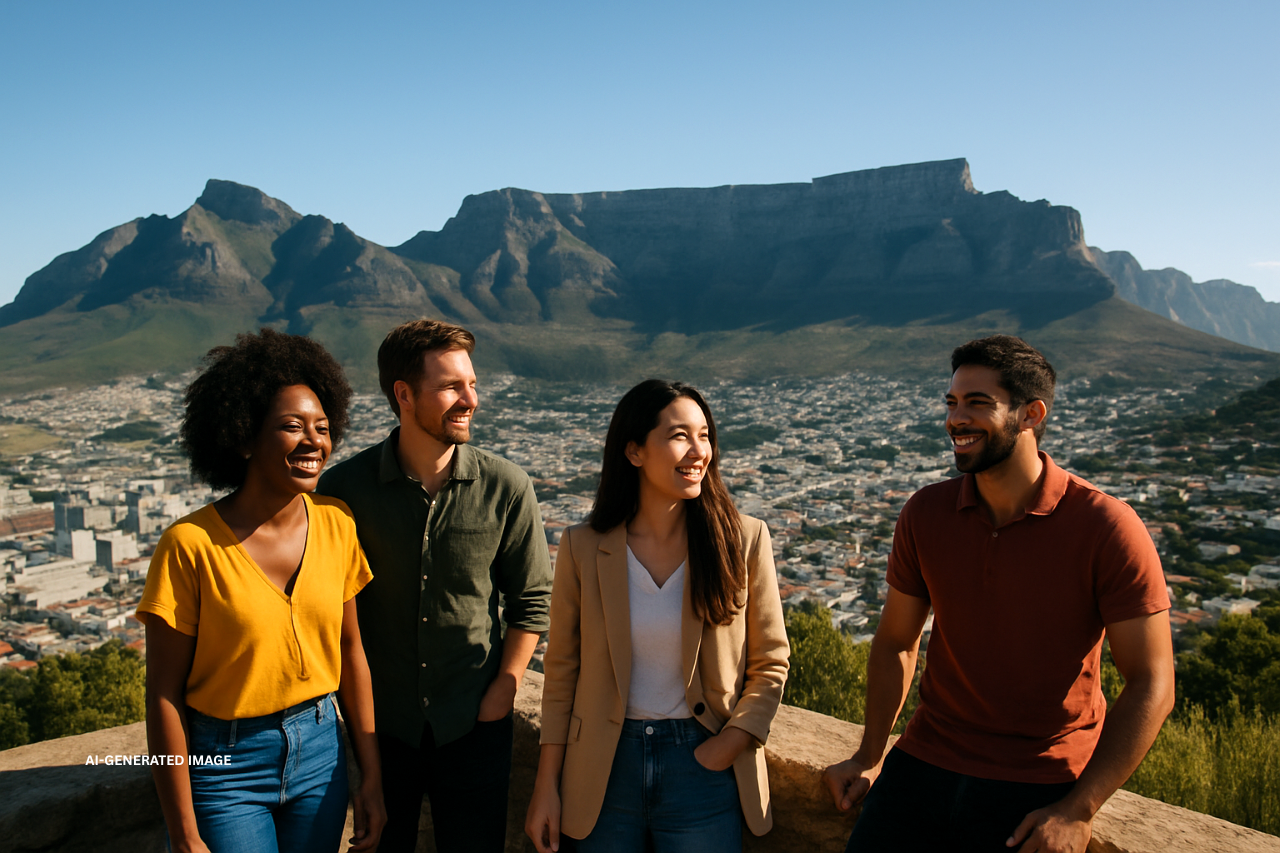
-
Table Mountain:
-
The city’s most iconic landmark, offering both hiking trails and a cable car ride to the summit, with panoramic views.
-
Robben Island:
-
A UNESCO World Heritage Site where Nelson Mandela and other political prisoners were held. Tours, often led by former inmates, give a powerful insight into South Africa’s past.
-
V&A Waterfront:
-
A lively harbor area filled with shops, restaurants, museums, and entertainment venues.
-
Cape Point and the Cape of Good Hope are famous for rugged scenery where the Atlantic and Indian Oceans meet.
-
Beaches:
-
Camps Bay and Clifton are well known for their golden sands, turquoise waters, and social scene.
Johannesburg
Johannesburg, or Joburg, is the country’s largest city and financial hub, offering much more than skyscrapers and commerce.
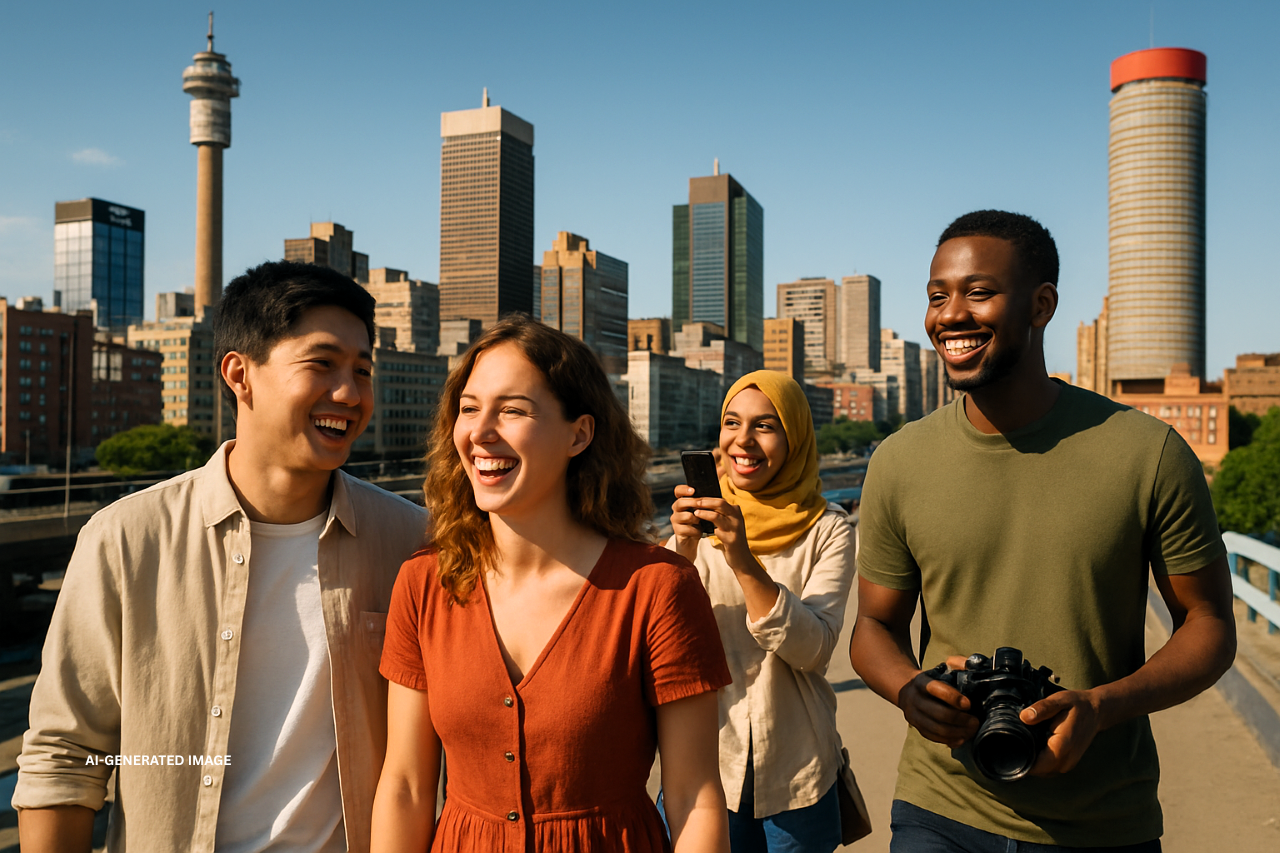
-
Apartheid Museum:
-
A compelling museum that chronicles South Africa’s struggle against racial segregation.
-
Soweto:
-
A township rich in history, with Vilakazi Street—the only street in the world where two Nobel Prize winners, Nelson Mandela and Desmond Tutu, once lived.
-
Constitution Hill:
-
A former prison turned museum that now houses the Constitutional Court, symbolizing the country’s democratic transformation.
-
Gold Reef City:
-
An amusement park and cultural attraction built on an old gold mine, combining family fun with history.
Durban
Durban, located on the Indian Ocean, is a beachside city with a laid-back vibe and a strong Indian cultural influence.
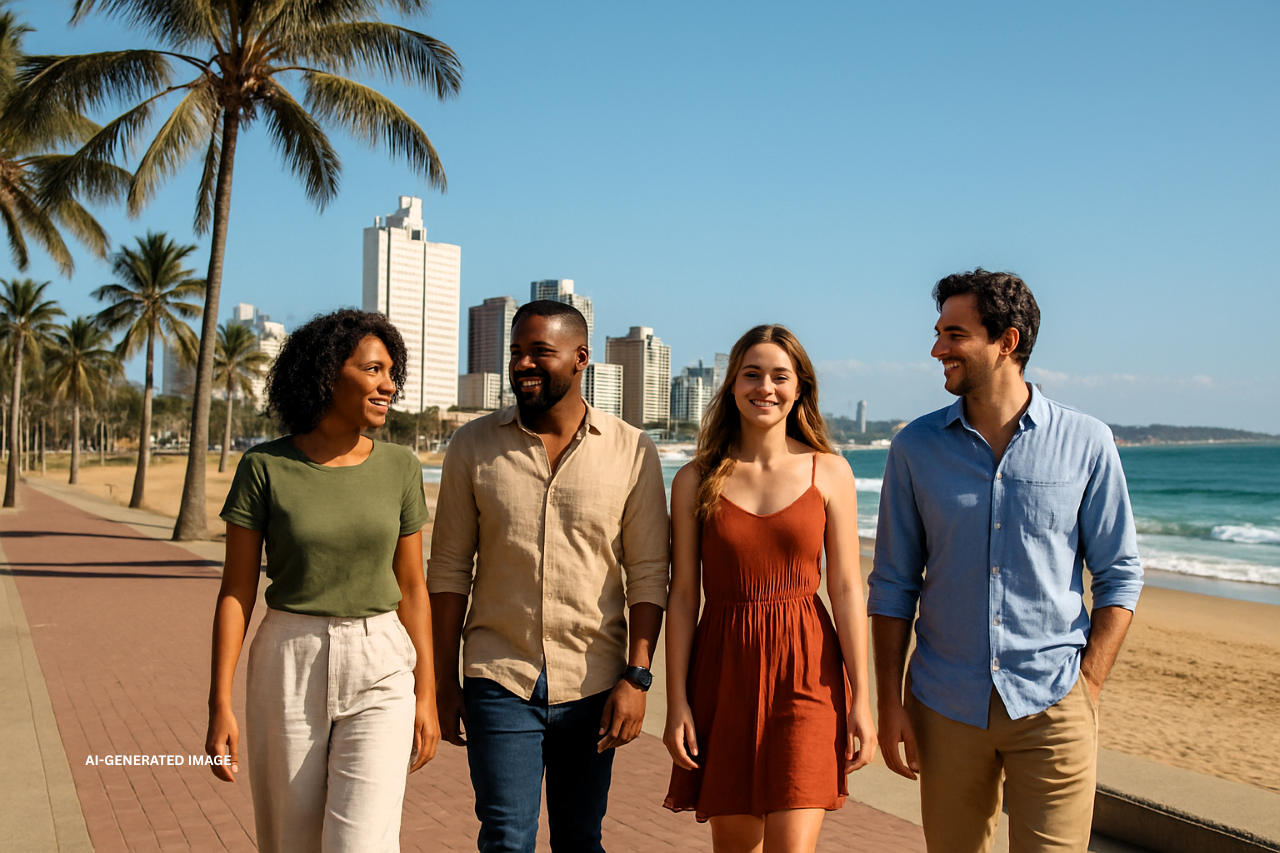
-
Golden Mile:
-
A vibrant stretch of beach, perfect for surfing, swimming, and family walks along the promenade.
-
uShaka Marine World:
-
An aquarium and waterpark offering both education and entertainment.
-
Markets and Food:
-
Durban is famous for its flavorful curries and spice markets, reflecting its large Indian community.
-
Gateway Theatre of Shopping:
-
One of the largest malls in the Southern Hemisphere, with shopping, dining, and entertainment.
Pretoria
As South Africa’s administrative capital, Pretoria blends history with a more relaxed atmosphere.
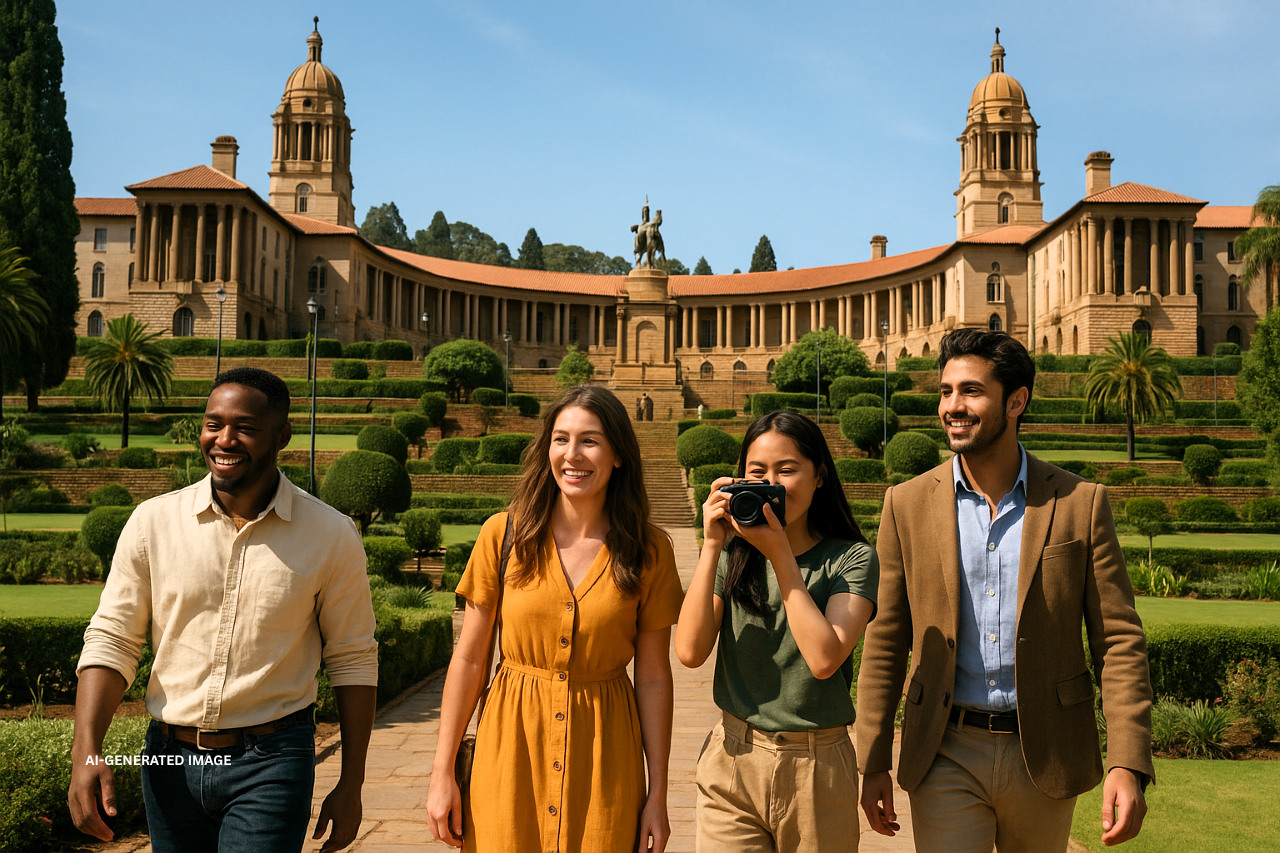
-
Union Buildings:
-
The official seat of government is known for its striking architecture and gardens.
-
Voortrekker Monument:
-
A national heritage site commemorating Afrikaner pioneers.
-
Freedom Park:
-
A memorial honoring those who fought for South Africa’s freedom and democracy.
-
Jacaranda Season:
-
In spring, the city’s streets turn purple as thousands of jacaranda trees bloom.
Port Elizabeth (Gqeberha)
Often called the “Friendly City,” Port Elizabeth is a coastal destination with a welcoming atmosphere.

-
Donkin Heritage Trail:
-
A walking route that connects important historical landmarks.
-
Beaches:
-
King’s Beach and Hobie Beach are perfect for families and water sports.
-
Addo Elephant National Park:
-
Just outside the city, this park is famous for its elephant herds and diverse wildlife.
Bloemfontein
Bloemfontein, also known as the “City of Roses,” is the judicial capital of South Africa.
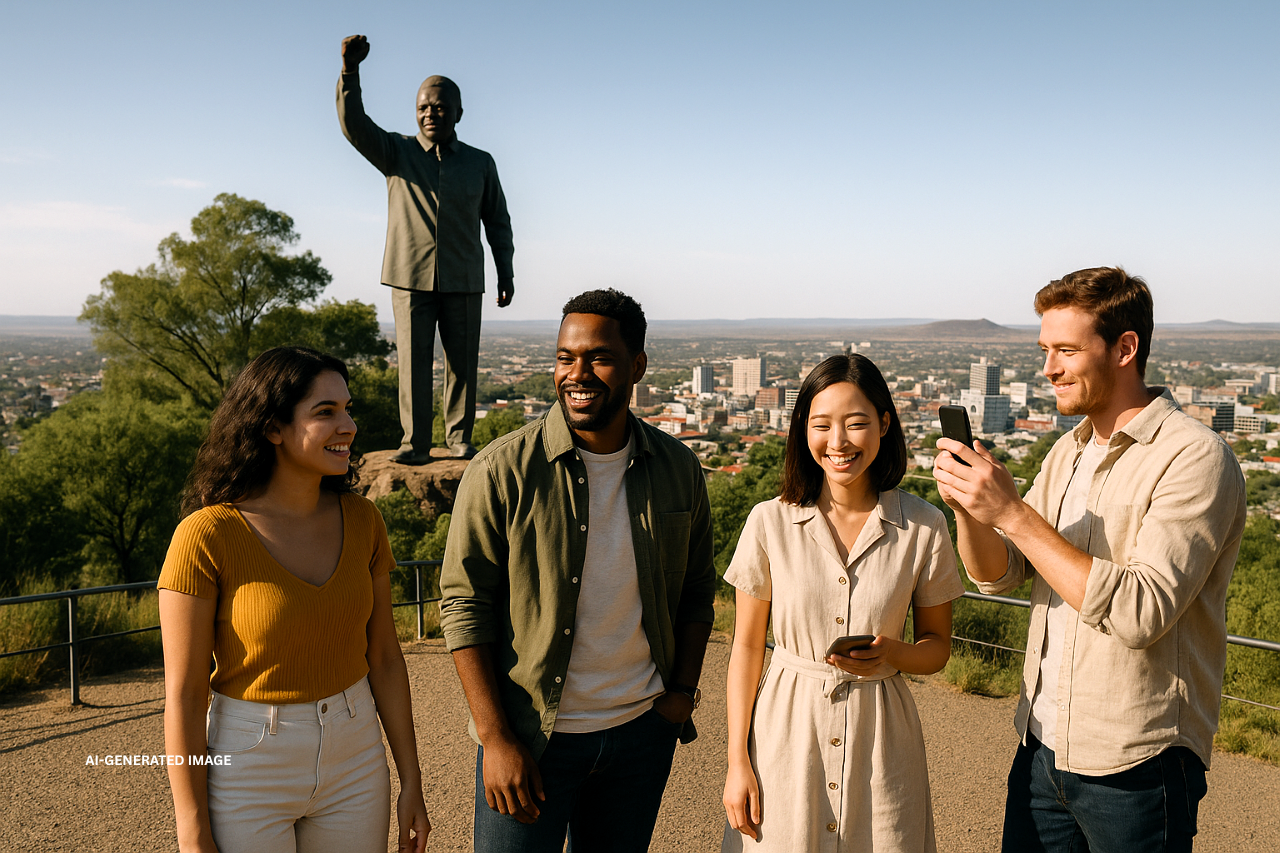
-
National Museum:
-
Features natural history, art, and cultural exhibits.
-
Naval Hill:
-
Offers panoramic views of the city and a large statue of Nelson Mandela.
-
Franklin Game Reserve:
-
A unique urban reserve, home to giraffes, antelopes, and other wildlife.
Scenic Routes and Landscapes
South Africa is one of the world’s best countries for road trips, with scenic routes showcasing its natural beauty.
-
The Garden Route:
-
This iconic coastal drive stretches from Mossel Bay to Storms River. It includes picturesque towns like Knysna and Plettenberg Bay, as well as forests, lagoons, and adventure activities such as bungee jumping.
-
The Panorama Route:
-
Found in Mpumalanga, it features breathtaking sites like Blyde River Canyon, God’s Window, and Bourke’s Luck Potholes. It’s a favorite for photographers.
-
The Wine Routes:
-
The Cape Winelands, particularly Stellenbosch, Franschhoek, and Paarl, offer scenic drives through vineyards, with opportunities for wine tasting and gourmet dining.
-
The Wild Coast:
-
A rugged stretch in the Eastern Cape, known for its untouched beaches, dramatic cliffs, and traditional Xhosa villages.
These routes allow travelers to experience South Africa’s diversity at a slower pace, with endless opportunities to stop and explore.
History and Heritage Tourism
South Africa’s history is layered and complex, but exploring its heritage sites helps visitors understand the struggles and triumphs that shaped the nation.
-
Robben Island:
-
Just off Cape Town, this former prison is a symbol of the country’s fight for freedom. Guided tours bring history to life.
-
Apartheid Museum (Johannesburg):
-
A moving museum that explains Apartheid with interactive displays, films, and personal accounts.
-
Constitution Hill (Johannesburg):
-
Once a notorious prison, it now houses the Constitutional Court, representing justice and equality.
-
KwaZulu-Natal Battlefields:
-
Historic sites like Isandlwana and Rorke’s Drift tell stories of conflicts between Zulu warriors and British troops.
-
Heritage Towns:
-
Stellenbosch:
-
It is known for its Cape Dutch architecture and as a center of wine production.
-
Graaff-Reinet:
-
Nicknamed the “Gem of the Karoo,” it has over 200 heritage sites.
-
Kimberley:
-
Famous for its diamond mining history and the Big Hole, one of the world’s largest hand-dug excavations.
-
These landmarks not only preserve history but also honor the resilience of the South African people.
Beaches and Coastline
South Africa’s coastline stretches more than 2,500 kilometers along both the Atlantic and Indian Oceans, offering some of the most beautiful and varied beaches in the world. From cosmopolitan city shores to remote and untouched stretches, there’s a beach to suit every type of traveler.
-
Camps Bay and Clifton (Cape Town):
-
These stylish beaches are famous for golden sands, clear waters, and a vibrant atmosphere. Camps Bay is lined with restaurants and cafés, while Clifton’s four beaches offer a quieter, more exclusive setting.
-
Durban’s Golden Mile:
-
A lively beachfront promenade perfect for swimming, surfing, and family outings. The warm waters of the Indian Ocean make it one of the country’s busiest beach areas.
-
The Wild Coast:
-
Rugged, less developed, and breathtakingly beautiful, this coastline is dotted with cliffs, rolling hills, and small villages. It’s ideal for travelers seeking natural beauty and cultural encounters.
-
Jeffreys Bay:
-
Considered one of the world’s premier surfing destinations, it attracts surfers from across the globe with its legendary right-hand point break.
-
Boulders Beach:
-
Located near Cape Town, this beach is home to a colony of African penguins. Visitors can swim and sunbathe just meters away from these charming birds.
Festivals and Events
South Africa’s cultural calendar is filled with exciting festivals that showcase its diversity, creativity, and sense of celebration.
-
Cape Town International Jazz Festival:
-
Known as “Africa’s Grandest Gathering,” it attracts world-class jazz artists and audiences from around the globe.
-
Knysna Oyster Festival:
-
A ten-day event combining sport, food, and family entertainment, set in the scenic Garden Route.
-
National Arts Festival (Makhanda):
-
Africa’s largest annual arts festival, featuring theatre, dance, music, and visual arts.
-
Durban July:
-
A glamorous horse-racing event that combines fashion, entertainment, and sport.
-
Hermanus Whale Festival:
-
Celebrated during the annual whale migration, this event includes parades, performances, and marine conservation activities.
These festivals offer visitors a chance to experience South Africa’s culture at its most vibrant.
Shopping and Souvenirs
Shopping in South Africa ranges from bustling markets to modern malls, offering visitors a wide choice of unique souvenirs.
-
Craft Markets:
-
Places like Greenmarket Square in Cape Town and Rosebank Market in Johannesburg sell beadwork, handwoven baskets, wooden carvings, and textiles.
-
Jewelry and Gemstones:
-
South Africa is renowned for its gold and diamonds. Visitors can buy jewelry or tour historic mines in Kimberley.
-
Clothing and Textiles:
-
Shweshwe fabrics, Zulu beadwork, and Xhosa-inspired attire make colorful and meaningful souvenirs.
-
Shopping Centers:
-
Sandton City in Johannesburg and Gateway Theatre of Shopping in Durban cater to those seeking luxury brands and modern retail experiences.
Shopping here provides both cultural immersion and stylish keepsakes.
Practical Travel Tips
A little preparation goes a long way in making your trip to South Africa smooth and enjoyable.
-
Visas and Entry:
-
Many nationalities enjoy visa-free entry for short stays, but travelers should confirm requirements before their trip.
-
Transportation:
-
Domestic flights connect major cities efficiently. Car rentals are popular for road trips such as the Garden Route, while public transport is limited in some areas.
-
Safety:
-
South Africa is safe for tourists who take sensible precautions. Avoid displaying valuables, stick to well-known tourist areas, and use reputable transport providers.
-
Currency:
-
The local currency is the South African Rand (ZAR). Credit cards are widely accepted, but carrying some cash is useful for markets and smaller towns.
-
Health:
-
Malaria precautions are necessary in certain areas, particularly near Kruger National Park. Comprehensive travel insurance is highly recommended.
Sustainable Tourism
South Africa is increasingly focused on eco-friendly and community-driven tourism.
-
Eco-Lodges:
-
Many safari camps and lodges rely on solar energy, recycle water, and minimize waste.
-
Community-Based Tourism:
-
Township tours and rural homestays give travelers authentic cultural experiences while supporting local families.
-
Wildlife Conservation:
-
Visitors can join volunteer programs dedicated to protecting elephants, rhinos, and marine species.
-
Responsible Travel:
-
Tourists are encouraged to respect local cultures, avoid plastic waste, and support businesses that reinvest in communities.
Choosing sustainable travel options helps protect South Africa’s cultural and natural heritage for generations to come.
Conclusion
South Africa is a destination of extraordinary contrasts. Towering mountains overlook golden beaches, wildlife thrives across expansive plains, and vibrant cities blend history with modern innovation. It is a place where travelers can explore diverse landscapes, connect with unique cultures, and reflect on a powerful history.
Whether you dream of thrilling safaris, scenic road trips, cultural festivals, or relaxing beach escapes, South Africa has it all. More than just a vacation spot, it offers experiences that will stay with you for a lifetime.
FAQs
What is the best time to visit South Africa?
The dry winter months (May–September) are ideal for safaris, while summer (November–March) is best for beaches and coastal trips.
Which cities should I include in my itinerary?
Cape Town, Johannesburg, Durban, Pretoria, Port Elizabeth (Gqeberha), and Bloemfontein are must-see destinations.
Is South Africa safe for tourists?
Yes, if basic precautions are taken. Stick to tourist areas, avoid isolated places at night, and use trusted transportation.
How long should I spend in South Africa?
Two weeks is ideal for a mix of cities, safaris, and coastal experiences. Shorter trips can focus on one region, such as Cape Town and the Garden Route.
What is the local currency?
The South African Rand (ZAR). Credit cards are widely accepted, but carrying cash is useful in markets and small towns.
Do I need a visa to visit South Africa?
Many travelers can enter visa-free for up to 90 days. Always confirm requirements before your trip.
Where can I go on safari?
Kruger National Park is the most popular, but Addo Elephant, Hluhluwe–Imfolozi, and Kgalagadi Transfrontier parks are also excellent.
Can I rent a car for travel?
Yes, self-drive trips are common, and roads are generally in good condition. The Garden Route is especially popular for road trips.
What should I pack for my trip?
Light clothing for summer, warm layers for winter, comfortable shoes, sunscreen, and insect repellent for safaris.
Is South Africa family-friendly?
Absolutely. Many lodges, beaches, and attractions offer child-friendly facilities and activities.
